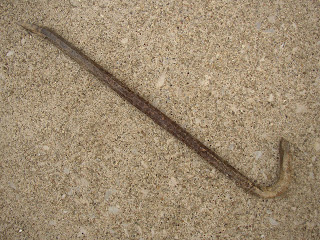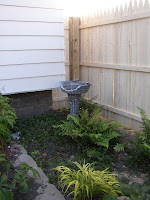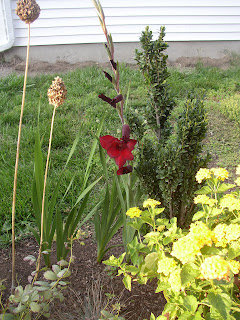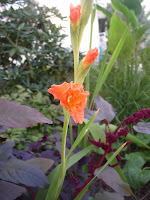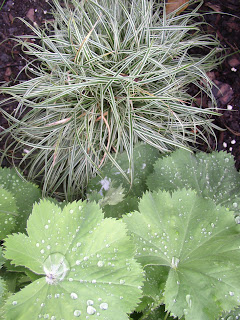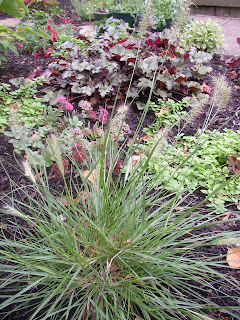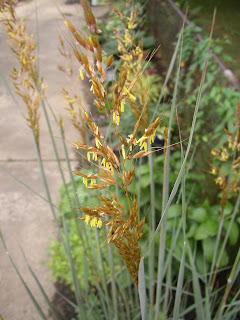
Even as I posted a picture of the baby-pink sedum flowers that so distressed me earlier this week, I knew that--as
Rosemarie pointed out--I was opening a can of worms. When pink does appear in my garden in the form of a
double Japanese anemone or an apricot-hued heuchera, it's always tamed with an acid green, deep plum, bronze-y brown, etc. I never purposely site it next to something like a baby purple--I'm just not a pastel kind of girl, that's all.
Plenty of other gardeners love pinks and pastels, though, and I've seen some pretty combinations of those shades in other garden posts. That started a thought tangent... I wondered what plants, accessories and designs other gardeners enjoy but were purposely keeping out of their own gardens, and why. And thus the NIMG challenge was born.
A few people have already gamely posted their lists, and you can find links to those in the
comments on the original post. (
Craig went above and beyond, including a well-Photoshopped fantasy image on his!) I did mean this challenge in
the strict interpretation that Elizabeth used in crafting her list, but I am glad to see that even when a much looser interpretation was used, things are staying relatively positive. If you decide to make a NIMG post yourself, feel free to leave a link in the comments so that others can find it.
Without further ado, here are some things that I can appreciate in other people's yards... but Not In My Garden:
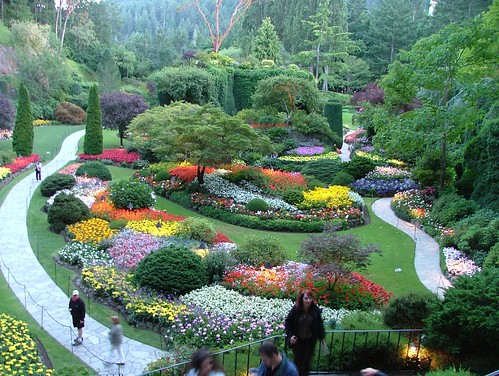
1)
Elaborate annual bedding schemes, like the one seen in
this picture taken by Jeffrey Beall.* While I love the riot of color, this has a formality and precision that I could probably not achieve even if I wanted to... I don't manicure my nails, and I don't manicure my garden, either.
Frankly, I prefer a whole lot of wildness in my garden. Maybe it's just in my nature, or maybe it's a reaction to all of the squared-off, plotted-out city that surrounds me here, I don't know. I have yet to figure that out. I just know that any formal designs or precise schemes are generally NIMG.
That said, I am, however, toying with the idea of using some formal elements to contrast with and highlight the wildness. Possibly a square lawn space (albeit with blue grama grass instead of the fussier fescues usually planted around here) and/or gently shaped evergreen shrubs. More on that in a later post.

2)
Japanese garden style. I love it. I have books on it, including the classic
Sakuteiki--and I have a lot of plants with handsome habits and interesting foliage like those often found in Japanese gardens. Like those you see in this photo of a true Japanese garden by
Manicosity.*
But I have long since faced this fact: There is no way I can ever be as restrained as I would need to be to have a proper Japanese garden. Not In My Garden. My garden makes me feel exhuberant and yes, maybe even sexy, but definitely not quiet and tranquil. (And, heck, I can't even make a blog post less than three screens long... so my lack of brevity shouldn't really come as a surprise to anybody.)

3)
White gardens are so elegant, and refreshing in a calm, cooling kind of way. (Just look at this picture of white petunias and alyssum posted by
Nic's events* and tell me it doesn't drop your pulse rate a bit.) Silvers combine well with them, and any monochromatic scheme allows you to play with texture--one of my favorite things to use in the garden.
I do have a few stray white flowers in my gardening, including a heavenly scented nicotiana sylvestris, but I will never have a true moon garden or all-white border. Why? Well, I absolutely
despise the dirty-tissue look of past-their-prime white blossoms, and I refuse to be a slave to daily deadheading. The white flowers I do have are about all that I can handle in the maintenance department, so all-white borders fall squarely under the category of NIMG.

4)
Well Planned Veggie Gardens. I dream of someday having a veggie garden with the beautiful, squared plots and straight paths seen at
dreams and bones, and
Skippy's Vegetable Garden, and uniform row cover hoops like those that
Steven sometimes shows. (And of course, I would be thrilled to have their levels of vegetable production!)
When asked why I do not yet have one of these in my own garden I generally blame it on a small yard requiring me to mingle edibles with ornamentals. But that's not entirely true. Some of the blame goes back to the formality issue I mentioned in #1 above, but my lack of garden planning skills is another cause.
Check out this garden picture from
domino nz's Flickr pages: Precise rows, planned by height, some successive planting thrown into the mix... all seem to be well outside of the realm of possibility for a plant-by-the-seat-of-her-pants girl like me. Not to mention that I don't do "row planting" very well anyway.

5)
Daylilies. Lots of gardeners whose gardens and blogs I admire (
Gotta Garden and
Karen among them) go crazy for daylilies. They look lovely en masse in this picture by
jacklail*, and one of my favorite sights in late summer is of the "ditch lilies," aka wild tiger lilies, blooming on the roadsides once you escape the confines of the city.
I even grew a few daylilies at my old house, in a bed with a 'Miss Kim' lilac, sedum and tall phlox. I couldn't tell you which ones I grew--frankly, most of the hundreds of ruffled, peachy colored ones with the reddish purple ring around the inside center look the same to me--but I can tell you why I decided not to even start with them here: their foliage leaves me cold.
I think I look at it daylilies as a grassy kind of plant in terms of design, and even though pennisetums and other ornamental grasses do not offer huge multicolored blooms I find them much more attractive out of flower than daylilies are. At the old house, I was always pulling browned leaves out of the daylily clumps, and several of the plants had daylily rust as well. And then there were the mushy remains of each flower at the end of the day.... ugh. So when I moved three years ago, I left the daylilies behind for good. I enjoy seeing the blooms in other people's garden pictures, but NIMG.
That covers the main things that I appreciate in other people's gardens, and I hope explains why I won't be using those designs or growing those plants in my own. As for the things that I don't like AND won't grow in my garden because of it... well, that's another post entirely! :)
*All pictures come from Flickr and have been designated as available for use under specific terms by those Flickr users who uploaded them. Please see this Flickr page for details.
 In hindsight, I should have taken some "before the fence" pictures for posterity's sake. I have spent so much time aiming around those views, however, that it simply never occurred to me that I might want some now. This picture from June, never posted exactly because I failed to crop out the background, is the best I can do.
In hindsight, I should have taken some "before the fence" pictures for posterity's sake. I have spent so much time aiming around those views, however, that it simply never occurred to me that I might want some now. This picture from June, never posted exactly because I failed to crop out the background, is the best I can do.



